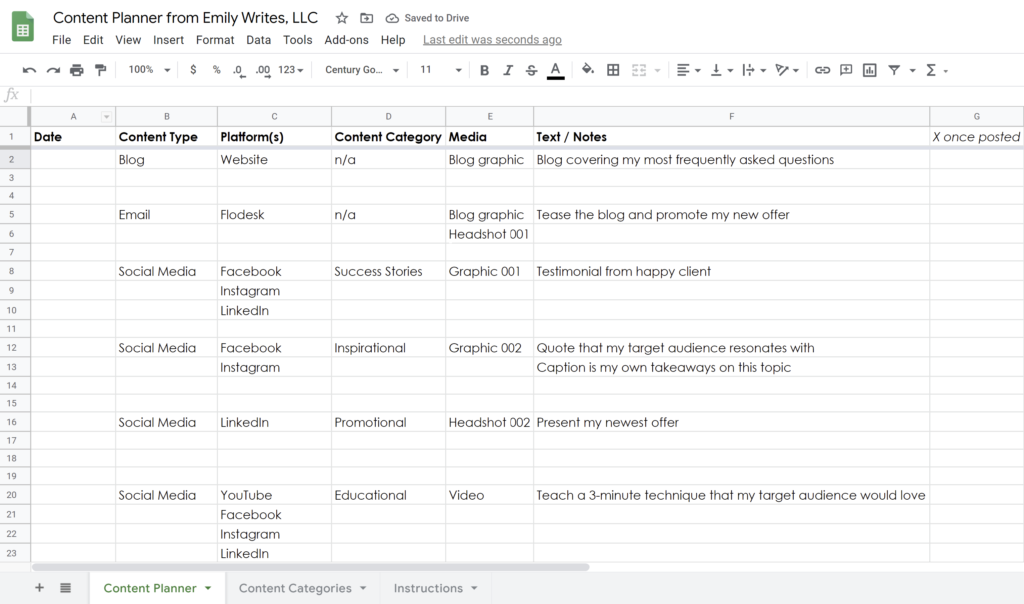I took two weeks off from work to close out 2021, staying logged out of ALL email and social media accounts the entire time.
… Just kidding 😆
While I did take two weeks off to focus on family and enjoy the holidays, my fellow entrepreneurs can probably relate to the fact that business never sleeps, especially when you work for yourself.
In addition to keeping an eye on my clients’ social media channels and ensuring that my team had their writing assignments for early 2022, I spent several hours strategizing my next 12 months.
To ensure that I can show up consistently on the Emily Writes social media channels, blog, and email newsletter in 2022, I need a plan. And I managed to create that entire plan in about one hour.
Let’s dive into my step-by-step process for creating a content calendar!
Step 1: Start with the Sales/Marketing Vision
Before throwing a million ideas at the wall, start with your overall sales/marketing vision for the year ahead. Ask yourself:
- What product or service line(s) do I want to grow?
- How do my clients/customers enjoy hearing from me?
- Where am I most excited about spending my marketing time?
- Will I create content myself or do I need a trusted partner?
Keep your answers in the back of your mind as you complete the rest of this checklist.
Step 2: Strategize each Channel
It’s important that you focus your precious time on the channels that make the most sense for your business. Consider where your ideal audience members are most likely to spend their time.
- Are they using social media? If so, which channels?
- Are they more likely to watch a video, listen to a podcast, or read a blog?
- Would they share their email address in order to hear from you on a regular basis?
At the end of this exercise, you should have a list. Ideally, that list would include at least one social media channel, one outlet for longer-form content (video, podcast, blog), and an email marketing list.
Next, jot down your overarching goal(s) for each content marketing outlet. Examples: Book discovery calls, create website sales, build thought leadership, grow email list, grow an engaged audience, find industry partners, grow affiliate income, book speaking engagements… The possibilities are endless and completely customizable to YOUR business!
Here’s what my list looked like, at this stage:

Step 3: Choose Content Categories
Now we’re getting to get to the fun part!
Make a list of the types of content you would like to create. Below, I’ve outlined nine “content buckets” that I use with my clients’ social media sites; you can choose anywhere from three to nine:
Promotional
Asking people to take the next step in buying your product or service.
Educational
Providing a resource such as a tip, resource, or video related to your expertise. This could be content you create yourself or content that you curate from a trusted source.
Branding
Talking about your “why” – your mission, values, or purpose of existing.
Behind-the-Scenes
Bringing people behind the curtain of your organization, such as showcasing how something is made or describing what goes into your process.
Company Culture
Showing what it’s like to work with you, such as a group meeting, employee spotlight, or talking about why people want to work for you.
Success Stories
Sharing testimonials or success stories from happy customers or clients.
Engagement
Inviting people to engage with your content with a question, poll, or contest.
Inspirational
Giving encouragement or motivation through a quote, a throwback story from your organization’s history, or another inspirational story.
Humorous
Sharing a funny cartoon, meme, or video. This could be something you create or something you curate from another source.
Here’s my list with social media content categories added, plus an outline for my blog and email topics:

Step 4: Choose a Realistic Posting Frequency
Once you’ve narrowed down your content channels and categories, decide how often you will be posting on your chosen platforms.
✨ Remember… QUALITY over QUANTITY!
You’re going to find a hundred different opinions online, regarding the “right” posting frequency. My rule of thumb is to post at a frequency that you can maintain consistently – without burning out – that still results in high-quality, valuable content every single time.
If you’re looking for guidance, based on my professional experience, reach out and schedule a consultation call!
Here’s my list with posting frequency added:

Step 5: Outline Your Content Calendar
Now you’re ready to create a social media calendar that reflects the types of content you chose and the frequency that makes the most sense! I utilize Google Spreadsheets to organize content for myself and my clients. Here’s a sample (click the image to download a free copy):
From there, I advise writing or recording your content in batches. You don’t have to write the entire year at once. That would be overwhelming! Aim to create at least one week’s worth of content at a time. I write one month at a time for myself and most of my clients.
Bonus Tips:
- To maximize work/life balance, I recommend software such as Agorapulse to schedule your posts ahead of time.
- Make sure you also set aside time to actively engage on your social media accounts. Here’s a free resource for how to engage strategically on LinkedIn (my favorite platform, btw!)
- Analyze your content marketing effectiveness at least once a quarter, so you can calibrate or pivot as necessary. Since you wrote down those goals in step 2, you now have a measuring stick! Every social media channel, website, and email marketing software provides analytics.
I hope this blog helped you get a handle on your 2022 content marketing calendar. Please reach out to me if any step in this process is confusing or unclear. I would be happy to provide further advice.

